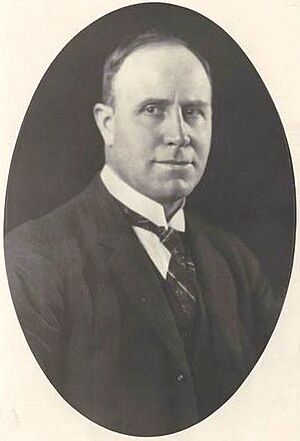Harry Lawson (politician) facts for kids
Quick facts for kids
Sir Harry Lawson
|
|
|---|---|
 |
|
| 27th Premier of Victoria | |
| In office 21 March 1918 – 28 April 1924 |
|
| Constituency | Castlemaine and Maldon |
| Preceded by | John Bowser |
| Succeeded by | Alexander Peacock |
| Senator for Victoria | |
| In office 1 July 1929 – 30 June 1935 |
|
| Personal details | |
| Born | 5 March 1875 Dunolly, Victoria, Australia |
| Died | 12 June 1952 (aged 77) East Melbourne, Victoria, Australia |
| Political party | Nationalist (1917–31) UAP (1931–35) |
| Spouse | Olive Adele Horwood |
Sir Harry Sutherland Wightman Lawson (born March 5, 1875, died June 12, 1952) was an important Australian politician. He was the leader of the state of Victoria as its Premier from 1918 to 1924. Later, he worked in the national government as a Senator for Victoria from 1929 to 1935. He was also a minister for a short time in the Lyons government. Sir Harry was a member of the Nationalist Party until 1931. This party later joined to form the United Australia Party.
Contents
Growing Up and Early Career
Harry Lawson was born in Dunolly, a town in Victoria. His father was a Presbyterian clergyman from Scotland. Harry went to a local school and then briefly attended Scotch College in Melbourne. He was a good Australian rules football player for the Castlemaine team.
He studied law with a law firm in Melbourne and became a lawyer. He started his own law practice in Castlemaine. He was also elected to the town council and served as mayor in 1905. In 1901, he married Olive Horwood, and they had eight children together.
Working in State Politics
In December 1899, Harry Lawson was elected to the Victorian Legislative Assembly. This is like the state parliament for Victoria. He represented the area of Castlemaine as a Liberal member. He continued to represent this area, even as its boundaries changed, for 28 years.
From 1913 to 1915, he was the President of the Board of Land and Works. This was part of the government led by William Watt. Then, from 1915 to 1917, he served as Attorney-General and Solicitor-General under Alexander Peacock.
When the government led by John Bowser ended in March 1918, Harry Lawson became the new Premier. He also continued to be the Attorney-General and Minister of Labour.
Longest-Serving Premier
Harry Lawson became the longest-serving Premier Victoria had seen up to that time. He held this important position for six years in a row. This was a big achievement, as none of the 26 Premiers before him had done that.
During his time as Premier, the political landscape was changing. At the 1921 elections, Lawson's Nationalist Party won the most seats. However, they did not have a clear majority. Both the Labor Party and the Country Party preferred Lawson to each other. This allowed him to continue leading the government, even without a full majority.
Challenges as Premier
One of the biggest challenges Harry Lawson faced was the 1923 Victorian Police strike. This event led to riots and looting in the streets of Melbourne. There were also many difficult strikes in factories and mines. Lawson was known for being a strong leader during these times.
He did not immediately agree to the police's demands for better pay. However, once the strike was over, he set up a special investigation called a Royal Commission. This commission looked into the police's complaints and ended up giving them many of the things they wanted.
In September 1923, Lawson formed Victoria's first conservative coalition government. This meant his party joined forces with the Country Party. However, this partnership ended in March 1924 when the Country Party made demands Lawson could not accept. The Country Party members left the government and worked with the Labor Party to remove Lawson from power. After this, Lawson left his leadership role and became a regular member of parliament until he left state politics in October 1928.
Working in Federal Politics
In the 1928 national election, Harry Lawson was elected to the Senate. This is part of Australia's national parliament. He started his term in July 1929. For two years, he was part of the opposition, meaning his party was not in power.
In October 1933, he was appointed an Assistant Minister in the government led by Joseph Lyons and the United Australia Party. In 1934, he became the Minister in charge of Territories. In 1933, he was also honored with the title of Knight Commander of the Order of St Michael and St George. He decided to retire at the 1934 election, and his time in parliament ended in June 1935.
Later Life and Legacy
Sir Harry Lawson passed away in East Melbourne. Seven of his eight children survived him. His wife had passed away in 1949. His youngest son, who joined the Royal Australian Air Force, was sadly killed in 1941.
His daughter, Helen Mary Keays, received an award in 1972 for her services to women. His last surviving child, Ina Constance Watson, passed away in Melbourne in 2012.


